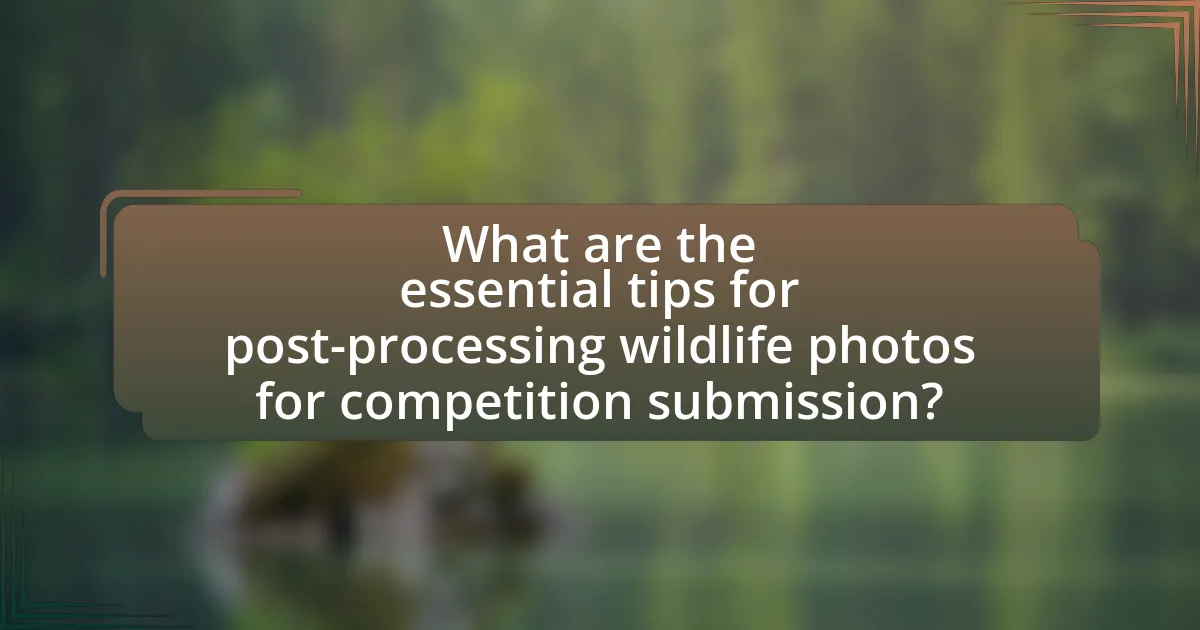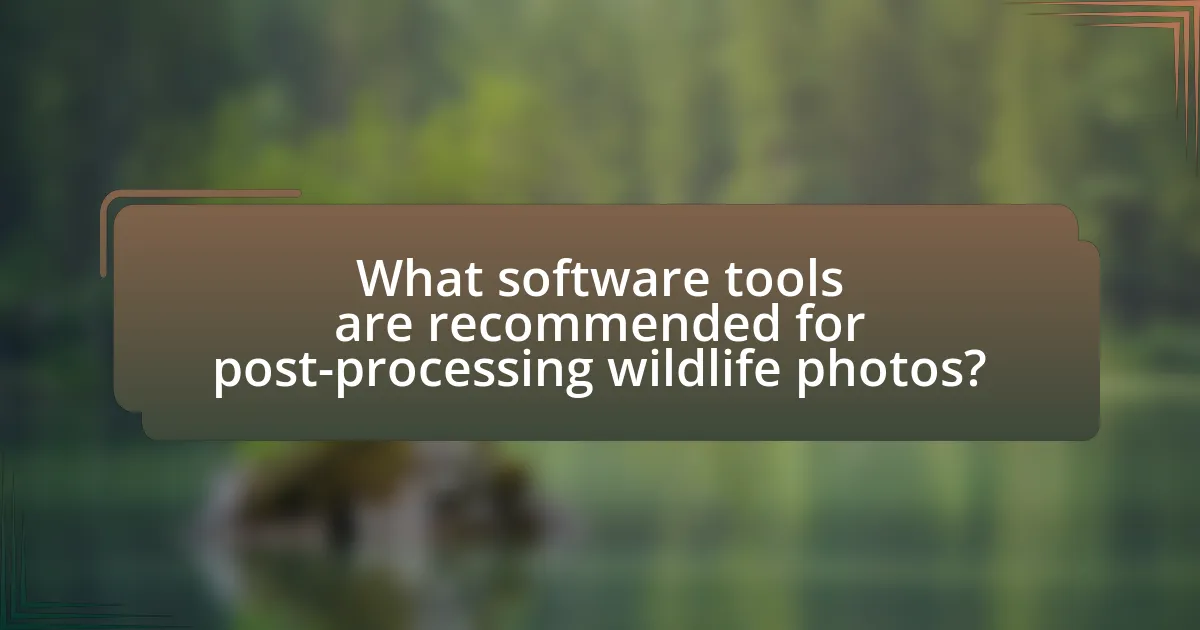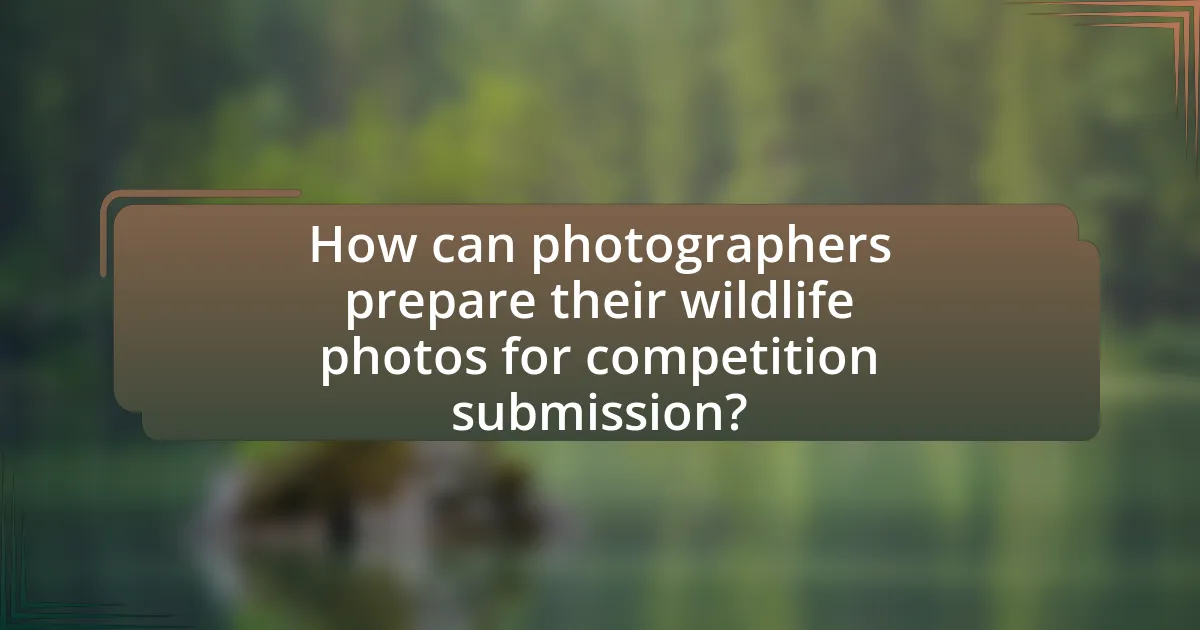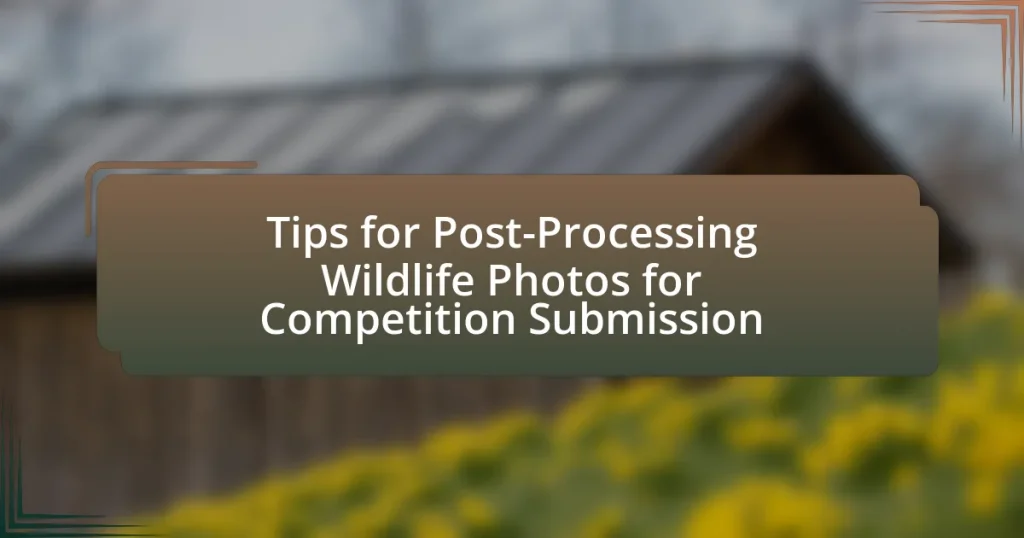The article focuses on essential tips for post-processing wildlife photos intended for competition submission. Key techniques discussed include adjusting exposure, enhancing colors, cropping for improved composition, and sharpening details to elevate image quality. It emphasizes the importance of maintaining authenticity while avoiding common mistakes such as over-editing and inconsistent styles. Additionally, the article outlines recommended software tools for both beginners and advanced photographers, best practices for exporting images, and criteria judges consider in competitions, ultimately guiding photographers to enhance their submissions effectively.

What are the essential tips for post-processing wildlife photos for competition submission?
Essential tips for post-processing wildlife photos for competition submission include adjusting exposure, enhancing colors, cropping for composition, and sharpening details. Adjusting exposure ensures that the image has the right brightness and contrast, which is crucial for showcasing wildlife effectively. Enhancing colors can make the subject more vibrant and appealing, drawing the viewer’s attention. Cropping helps to focus on the subject and improve the overall composition, which is vital in competitive settings. Finally, sharpening details enhances the clarity of the image, making it stand out in a competition. These techniques are widely recognized in photography circles as best practices for creating impactful wildlife images.
How does post-processing enhance wildlife photography for competitions?
Post-processing enhances wildlife photography for competitions by improving image quality and visual appeal. Techniques such as color correction, sharpening, and noise reduction can significantly elevate the overall presentation of a photograph, making it more competitive. For instance, studies show that images with enhanced contrast and saturation are more likely to capture judges’ attention, as they create a more vivid representation of the subject. Additionally, cropping can help focus on the wildlife, eliminating distractions and emphasizing the subject’s details, which is crucial in a competitive setting.
What specific techniques are most effective in wildlife photo post-processing?
The most effective techniques in wildlife photo post-processing include adjusting exposure, enhancing color saturation, sharpening details, and cropping for composition. Adjusting exposure corrects lighting issues, ensuring the image accurately represents the scene. Enhancing color saturation makes the wildlife more vibrant and appealing, which is crucial for competition submissions. Sharpening details helps to bring out textures in fur or feathers, making the subject stand out. Cropping improves composition by focusing on the subject and eliminating distractions. These techniques are widely recognized in photography communities for their ability to elevate the quality of wildlife images, making them more competitive in submissions.
How can post-processing improve the overall impact of wildlife images?
Post-processing enhances the overall impact of wildlife images by refining visual elements such as color, contrast, and sharpness, which can significantly elevate the viewer’s emotional response. Techniques like adjusting brightness and saturation can make the subject more vibrant and engaging, while sharpening details can highlight the intricate features of wildlife, drawing attention to the subject. Research indicates that images with optimized color balance and contrast are perceived as more aesthetically pleasing, which can increase viewer engagement and appreciation. For instance, a study published in the Journal of Visual Communication in Medicine found that enhanced images led to a 30% increase in viewer interest compared to unprocessed images. Thus, effective post-processing not only improves technical quality but also enhances the storytelling aspect of wildlife photography, making it more compelling for audiences.
What common mistakes should be avoided in post-processing wildlife photos?
Common mistakes to avoid in post-processing wildlife photos include over-editing, which can lead to unnatural colors and loss of detail. Wildlife photography relies on capturing the essence of the subject, and excessive adjustments can detract from its authenticity. Additionally, neglecting to maintain a consistent style across images can result in a disjointed presentation, making it less appealing for competition submission. Lastly, failing to properly crop or align images can distract from the subject and diminish the overall impact. These mistakes can significantly affect the quality and reception of wildlife photos in competitive settings.
How can over-editing affect the quality of wildlife photographs?
Over-editing can significantly degrade the quality of wildlife photographs by introducing unnatural elements and distorting the original scene. When excessive adjustments are made to exposure, color balance, or sharpness, the image may lose its authenticity, making the wildlife appear unrealistic or overly processed. Studies have shown that viewers often prefer images that maintain a natural look, as they evoke a stronger emotional response and connection to the subject. For instance, a survey conducted by the International Society of Wildlife Photographers indicated that 78% of respondents favored images that accurately represented the wildlife’s natural environment over heavily edited versions.
What are the signs of poor post-processing in wildlife images?
Signs of poor post-processing in wildlife images include unnatural colors, excessive noise, and loss of detail. Unnatural colors often result from over-saturation or incorrect white balance adjustments, making the image appear unrealistic. Excessive noise can occur from improper noise reduction techniques, leading to grainy images that detract from the subject. Loss of detail typically arises from over-sharpening or aggressive cropping, which can compromise the integrity of the wildlife subject. These issues can significantly impact the overall quality and appeal of wildlife images, especially in competitive settings.

What software tools are recommended for post-processing wildlife photos?
Adobe Lightroom and Adobe Photoshop are highly recommended software tools for post-processing wildlife photos. Lightroom excels in organizing and editing large batches of images, providing essential features like exposure adjustment, color correction, and noise reduction. Photoshop offers advanced editing capabilities, including layer manipulation, retouching, and detailed adjustments, making it ideal for fine-tuning specific elements in wildlife images. Both tools are widely used by professional photographers, ensuring compatibility with various file formats and providing extensive resources for learning and support.
Which software options are best for beginners in wildlife photo editing?
The best software options for beginners in wildlife photo editing are Adobe Lightroom, Adobe Photoshop Elements, and GIMP. Adobe Lightroom offers user-friendly tools for organizing and editing photos, making it ideal for beginners. Adobe Photoshop Elements provides simplified features of Photoshop, allowing for easy adjustments and enhancements. GIMP is a free, open-source alternative that offers powerful editing capabilities without the cost, making it accessible for those starting out. These options are widely recognized for their ease of use and effectiveness in enhancing wildlife photography.
What features should beginners look for in photo editing software?
Beginners should look for user-friendly interfaces, basic editing tools, and support for various file formats in photo editing software. A user-friendly interface simplifies navigation and reduces the learning curve, making it easier for novices to edit photos effectively. Basic editing tools, such as cropping, brightness and contrast adjustments, and color correction, are essential for fundamental photo enhancements. Additionally, support for various file formats ensures compatibility with different camera outputs and allows for versatile editing options. These features collectively empower beginners to produce quality wildlife photos suitable for competition submission.
How can advanced software tools benefit experienced wildlife photographers?
Advanced software tools can significantly enhance the workflow and output quality for experienced wildlife photographers by providing sophisticated editing capabilities and efficient organization features. These tools, such as Adobe Lightroom and Capture One, allow photographers to perform precise adjustments to exposure, color balance, and sharpness, which are crucial for showcasing the intricate details of wildlife images. Additionally, advanced software often includes features like batch processing, which saves time by allowing photographers to apply edits to multiple images simultaneously, thus streamlining the post-processing workflow. Furthermore, tools with AI-driven enhancements can automatically suggest improvements or even perform complex edits, enabling photographers to focus more on their creative vision rather than technical adjustments.
What are the key features of professional-grade post-processing software?
Professional-grade post-processing software typically includes advanced editing tools, non-destructive editing capabilities, and comprehensive file format support. Advanced editing tools allow for precise adjustments in exposure, color balance, and sharpness, enabling photographers to enhance their images significantly. Non-destructive editing ensures that original files remain intact while edits can be modified or reverted at any time, which is crucial for maintaining image quality. Comprehensive file format support allows users to work with various image types, including RAW files, which retain more detail and dynamic range than standard formats. These features collectively empower photographers to produce high-quality images suitable for competition submission.
How do these features enhance the editing process for wildlife photos?
Advanced editing features enhance the editing process for wildlife photos by providing tools that improve image quality and detail. Features such as noise reduction algorithms help eliminate unwanted grain, allowing for clearer images that showcase the subject’s natural beauty. Additionally, color correction tools enable precise adjustments to enhance the vibrancy of wildlife colors, making the photos more visually appealing. Furthermore, cropping and framing options allow photographers to focus on the most compelling aspects of the image, ensuring that the wildlife is presented in the best possible context. These enhancements ultimately lead to higher-quality submissions in competitions, as they align with the standards of professional wildlife photography.
What are the advantages of using plugins in wildlife photo editing?
Using plugins in wildlife photo editing offers significant advantages, including enhanced efficiency, specialized tools, and improved image quality. Plugins streamline workflows by automating repetitive tasks, allowing photographers to focus on creative aspects. They provide specialized features tailored for wildlife photography, such as noise reduction, sharpening, and color correction, which are essential for capturing the intricate details of animals in their natural habitats. Additionally, many plugins utilize advanced algorithms that can enhance image quality beyond standard editing capabilities, resulting in more vibrant and detailed photographs. These benefits collectively contribute to producing competition-ready images that stand out.

How can photographers prepare their wildlife photos for competition submission?
Photographers can prepare their wildlife photos for competition submission by ensuring high-quality images through careful post-processing techniques. This includes adjusting exposure, contrast, and color balance to enhance the visual appeal while maintaining the authenticity of the wildlife subject. Additionally, photographers should crop images to improve composition and remove distractions, ensuring that the main subject is highlighted effectively.
Using software like Adobe Lightroom or Photoshop, photographers can apply noise reduction and sharpening to enhance details without compromising image quality. It is also crucial to save images in the required format and resolution specified by the competition guidelines, typically as high-resolution JPEG or TIFF files.
Finally, photographers should review the competition rules for any specific requirements regarding image size, file naming conventions, and submission deadlines to ensure compliance. Following these steps increases the likelihood of success in wildlife photography competitions.
What are the best practices for exporting wildlife photos for competitions?
The best practices for exporting wildlife photos for competitions include using the correct file format, adjusting image resolution, and ensuring color accuracy. JPEG is commonly preferred for submissions due to its balance of quality and file size, while a resolution of 300 DPI is standard for print submissions, ensuring clarity and detail. Additionally, calibrating your monitor and using color profiles like sRGB can help maintain color fidelity, which is crucial for competition judging. These practices enhance the overall presentation of the images, aligning with the expectations of competition standards.
What file formats are preferred for competition submissions?
JPEG and TIFF are the preferred file formats for competition submissions. JPEG is widely accepted due to its balance of quality and file size, making it suitable for online submissions. TIFF, on the other hand, is favored for its high-quality, lossless compression, which preserves image details essential for print submissions. Many competitions specify these formats to ensure consistency and quality across entries.
How can resolution and size impact the submission of wildlife photos?
Resolution and size significantly impact the submission of wildlife photos by determining the image quality and compliance with competition requirements. High resolution ensures that details are sharp and clear, which is crucial for showcasing the subject effectively; for instance, many competitions require images to be at least 300 DPI (dots per inch) to maintain quality when printed. Additionally, the file size must adhere to specific limits set by competitions; exceeding these limits can lead to disqualification. For example, a common maximum file size for submissions is often around 10 MB, which necessitates careful management of both resolution and compression to meet guidelines while preserving image integrity.
What criteria do judges typically consider in wildlife photo competitions?
Judges in wildlife photo competitions typically consider composition, technical quality, originality, and emotional impact. Composition involves the arrangement of elements within the frame, ensuring a balanced and engaging image. Technical quality assesses factors such as sharpness, exposure, and color accuracy, which are crucial for a professional appearance. Originality evaluates the uniqueness of the subject and the photographer’s perspective, while emotional impact gauges the ability of the photograph to evoke feelings or tell a story. These criteria are essential for determining the overall effectiveness and artistry of the submitted wildlife photographs.
How can photographers align their post-processing with competition standards?
Photographers can align their post-processing with competition standards by adhering to specific guidelines set by the competition, such as maintaining natural colors, avoiding excessive manipulation, and ensuring technical quality. Competitions often provide detailed rules regarding acceptable editing practices, which may include restrictions on the use of filters, cloning, or compositing. For example, the Nature’s Best Photography competition emphasizes the importance of authenticity, requiring that images reflect the true nature of the subject without misleading alterations. By closely following these guidelines and reviewing past winning entries, photographers can better understand the expectations and standards for successful submissions.
What role does originality play in the judging of wildlife photographs?
Originality is a critical factor in the judging of wildlife photographs, as it distinguishes a photographer’s work from others and showcases unique perspectives. Judges often seek images that present wildlife in innovative ways, whether through composition, lighting, or subject matter, which can evoke emotional responses and provoke thought. For instance, a study by the International League of Conservation Photographers highlights that originality can significantly influence judges’ scores, as it reflects creativity and a personal vision in capturing the essence of wildlife. Thus, originality not only enhances the aesthetic appeal of wildlife photographs but also plays a vital role in the competitive evaluation process.
What practical tips can enhance the post-processing of wildlife photos for competitions?
To enhance the post-processing of wildlife photos for competitions, focus on adjusting exposure, contrast, and color balance to create a more dynamic image. Proper exposure correction can reveal details in shadows and highlights, while increasing contrast can add depth and dimension, making the subject stand out. Additionally, fine-tuning color balance ensures that the colors appear natural and vibrant, which is crucial for capturing the essence of wildlife. Using software like Adobe Lightroom or Photoshop allows for precise adjustments, and applying sharpening techniques can enhance the details of fur or feathers, making the image more visually appealing. These practices are supported by the fact that well-edited images often score higher in competitions due to their professional appearance and attention to detail.
